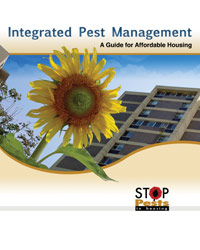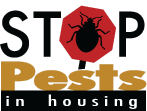Integrated Pest Management: A Guide for Affordable Housing
Affordable multifamily housing presents unique challenges for those trying to manage bed bugs, cockroaches, and rodents. Pest-free housing is a realistic goal, but a network of staff, pest management professionals, and residents must cooperate to successfully manage pests building-wide.
 |
Integrated Pest Management: A Guide for Affordable Housing is a resource that will help affordable housing managers, owners, and agents use integrated pest management (IPM) to contend with a variety of urban pests in their facilities. It will also serve as a useful tool for anyone seeking to integrate IPM practices into a residential pest management strategy.
The illustrated, 81-page guide gives readers
- a basic knowledge of pests and pesticides that will help them make informed pest control decisions with a pest management professional;
- an understanding of how to implement IPM in housing; and
- tools to orient staff to their role on an IPM team.
 Integrated Pest Management: A Guide for Affordable Housing (entire publication in English, PDF, 25 MB)
Integrated Pest Management: A Guide for Affordable Housing (entire publication in English, PDF, 25 MB)
 Manejo Integrado de Plagas: Una Guía para la Vivienda Accesible (páginas 1–42 en español, PDF, 23 MB)
Manejo Integrado de Plagas: Una Guía para la Vivienda Accesible (páginas 1–42 en español, PDF, 23 MB)
Download the appendices separately
- Appendix A. U.S. Department of Housing and Urban Development Office of Public and Indian Housing Promotion of Integrated Pest Management (IPM) as an environmentally-sound, economical and effective means to address a major resident concern (Notice: PIH-2011-22) (PDF)
- Appendix B. U.S. Department of Housing and Urban Development Office of Public and Indian Housing Guidelines on Bedbug Control and Prevention in Public Housing (Notice: PIH 2012-17) (PDF)
- Appendix C. U.S. Department of Housing and Urban Development Guidelines on Addressing Infestations in HUD-insured and Assisted Multifamily Housing (Notice: H 2012-5) (PDF)
- Appendix D. IPM Focus Unit Tracking Log (DOCX)
- Appendix E. Sample Request for Proposal (RFP) and Scope of Work for Pest Control (including site-specific IPM plan guidelines) (DOCX)
- Appendix F. Suggested Housekeeping and Lease Language
- Appendix G. Employee Certificate of Completion (PDF)
Integrated Pest Management: A Guide for Affordable Housing was developed by the Northeastern IPM Center as part of “Delivery of IPM Training to Public Housing Authorities,” a project supported through an interagency agreement between the U.S. Department of Agriculture’s National Institute of Food and Agriculture (USDA-NIFA) and the U.S. Department of Housing and Urban Development (HUD) Office of Healthy Homes and Lead Hazard Control. The guide is based on a training curriculum that was reviewed and supported by the National Center for Healthy Housing (NCHH), National Pest Management Association (NPMA), Pennsylvania IPM Program, U.S. Centers for Disease Control and Prevention (CDC), HUD, USDA-NIFA, and U.S. Environmental Protection Agency (EPA).

